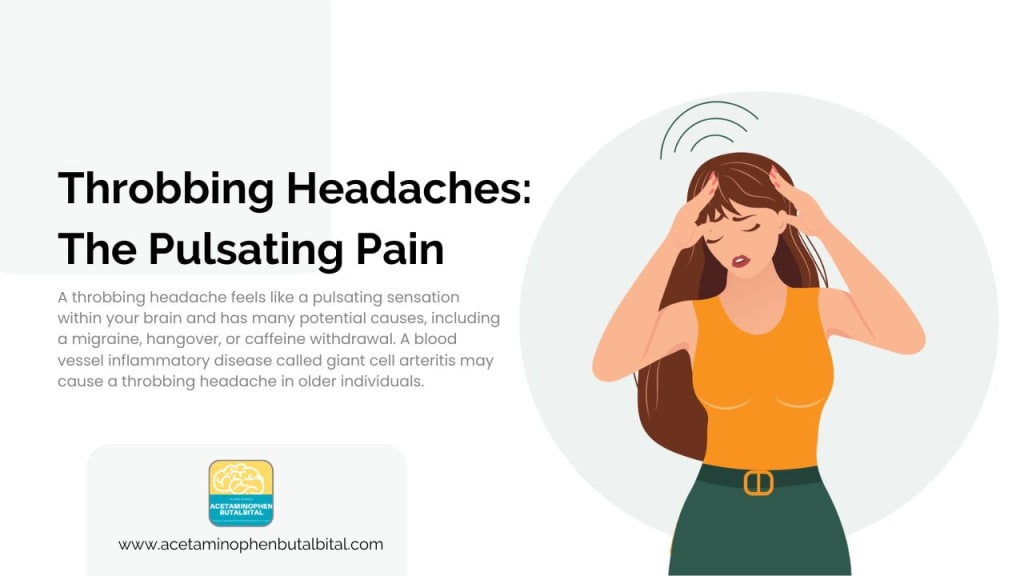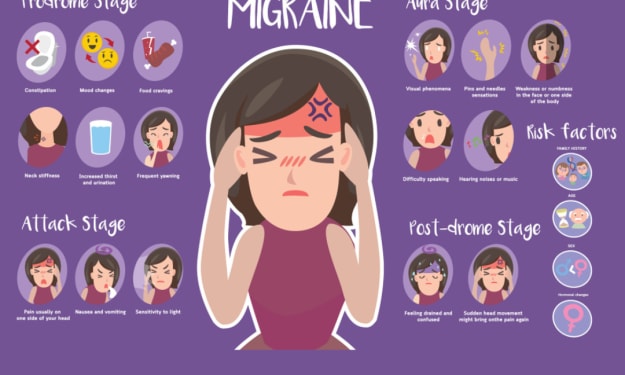Throbbing Headaches: Understanding the Pulsating Pain
Throbbing Headaches (Pulsating Pain)

Headaches are a common ailment that many of us experience at some point in our lives. Among the various types, throbbing headaches stand out for their pulsating and intense nature. In this article, we'll delve into the intricacies of throbbing headaches, exploring their types, causes, symptoms, and effective treatment options.
Types of Throbbing Headaches
Migraines
Migraines are a prevalent form of throbbing headaches characterized by severe pain, often accompanied by nausea, vomiting, and sensitivity to light and sound. Understanding the triggers and patterns can help manage and prevent migraines effectively.
Tension Headaches
Tension headaches, another common type, typically result from stress and muscle tension. Exploring relaxation techniques and stress management strategies becomes crucial in mitigating the frequency and intensity of tension headaches.
Cluster Headaches
Cluster headaches, though less common, are excruciatingly painful and often occur in clusters or cycles. Identifying these patterns and seeking appropriate medical intervention are essential for those affected by cluster headaches.
Causes of Throbbing Headaches
Genetic Factors
Research suggests a genetic predisposition to migraines and other types of throbbing headaches. Understanding family history can provide insights into one's susceptibility and guide preventive measures.
Environmental Triggers
External factors such as bright lights, strong odors, and certain foods can trigger throbbing headaches. Identifying and avoiding these triggers form a crucial part of managing and preventing episodes.
Hormonal Influences
Fluctuations in hormones, particularly in women, can contribute to the onset of migraines. Recognizing hormonal patterns and seeking hormonal balance can be integral in managing hormonal headaches.
Symptoms
Throbbing headaches manifest through a range of symptoms, each contributing to the overall discomfort and distress.
Pulsating Pain
The hallmark of throbbing headaches is the pulsating or throbbing pain experienced by individuals. Understanding the nature of this pain aids in differentiating between types of headaches.
Sensitivity to Light and Sound
Many individuals with throbbing headaches experience heightened sensitivity to light and sound, adding to the overall discomfort during episodes.
Nausea and Vomiting
Nausea and vomiting are common accompanying symptoms, further impacting the quality of life for those dealing with throbbing headaches.
Diagnosis
Accurate diagnosis is crucial for effective management of throbbing headaches.
Medical History
Providing a detailed medical history, including the frequency and characteristics of headaches, aids healthcare professionals in making an accurate diagnosis.
Physical Examination
A thorough physical examination helps rule out other potential causes of headaches and guides further diagnostic measures.
Imaging Tests
In some cases, imaging tests such as MRIs or CT scans may be recommended to visualize any underlying issues contributing to throbbing headaches.
Treatment Options
Managing throbbing headaches involves a multi-faceted approach, combining medication, lifestyle changes, and alternative therapies.
Medications
Prescription and over-the-counter medications can help alleviate pain and reduce the frequency of throbbing headaches.
Fioricet stands as a potential solution for throbbing headaches, offering a combination of pain relief, muscle relaxation, and improved blood flow.
As with any medication, it's essential to use Fioricet Online under the guidance of a healthcare professional, considering individual health factors and potential side effects.
If you're experiencing persistent or severe throbbing headaches, consult with your doctor to determine the most suitable treatment plan for your specific needs.
Lifestyle Changes
Implementing lifestyle changes, such as maintaining a regular sleep schedule, managing stress, and staying hydrated, plays a significant role in preventing headaches.
Alternative Therapies
Some individuals find relief through alternative therapies like acupuncture, biofeedback, or herbal supplements. Exploring these options, under the guidance of a healthcare professional, can be beneficial.
Prevention Strategies
Preventing throbbing headaches involves proactive measures and lifestyle adjustments.
Identifying Triggers
Recognizing and avoiding personal triggers, whether they be certain foods, environmental factors, or stressors, is crucial for preventing headache episodes.
Stress Management
Incorporating stress management techniques, such as meditation, deep breathing exercises, or yoga, can significantly reduce the frequency and intensity of throbbing headaches.
Regular Exercise and Adequate Sleep
Maintaining a healthy lifestyle, including regular exercise and sufficient sleep, contributes to overall well-being and can be instrumental in preventing headaches.
Impact on Daily Life
Throbbing headaches extend beyond the physical pain, impacting various aspects of daily life.
Work and Productivity
Managing throbbing headaches at the workplace requires communication with employers and implementing accommodations to ensure optimal productivity.
Relationships
Communicating the challenges of throbbing headaches to friends and family fosters understanding and support, crucial for navigating personal relationships.
Mental Health
The toll on mental health is a significant aspect, and seeking professional help to cope with the emotional impact is essential for overall well-being.
Coping Mechanisms
Support Groups
Joining support groups or online communities provides a platform for individuals to share experiences, tips, and emotional support in dealing with throbbing headaches.
Mindfulness and Relaxation Techniques
Incorporating mindfulness practices and relaxation techniques into daily routines can help manage stress and reduce the frequency of headaches.
Healthy Habits
Adopting healthy habits, such as maintaining a balanced diet, staying hydrated, and practicing good posture, contributes to overall well-being and can be beneficial in managing headaches.
When to Seek Medical Attention
Recognizing when to seek medical attention is crucial for timely intervention and proper management.
Red Flags
Certain symptoms, such as sudden and severe headaches, visual disturbances, or neurological symptoms, may indicate an underlying issue requiring urgent medical attention.
Emergency Situations
In emergency situations, such as persistent and severe headaches accompanied by neurological symptoms, seeking immediate medical help is paramount.
Consulting a Healthcare Professional
Regular consultations with a healthcare professional, especially for chronic or debilitating throbbing headaches, ensure a tailored treatment plan and ongoing support.
Research and Advancements
Ongoing research offers hope for advancements in understanding and treating throbbing headaches.
Ongoing Studies
Scientists and researchers continue to explore the underlying causes of throbbing headaches, leading to ongoing studies that may unveil new treatment options.
Promising Treatments
Emerging treatments, such as targeted medications and advanced therapies, show promise in providing relief for individuals dealing with throbbing headaches.
Future Outlook
The future outlook for throbbing headache management holds potential for more personalized and effective approaches based on evolving research and medical advancements.
Personal Stories
Real-life experiences shed light on the challenges and triumphs of individuals dealing with throbbing headaches.
Individuals Sharing Their Experiences
Sharing personal stories creates a sense of community and understanding, offering comfort and insights for others facing similar challenges.
Overcoming Challenges
Stories of overcoming challenges inspire hope and resilience, showcasing that effective management and a fulfilling life are achievable despite throbbing headaches.
Myths and Misconceptions
Dispelling common myths and misconceptions about throbbing headaches is crucial for accurate understanding and effective management.
Common Misconceptions About Throbbing Headaches
Addressing misconceptions, such as equating all headaches to migraines or relying solely on medication, promotes informed decision-making.
Debunking Myths
Providing evidence-based information helps debunk myths surrounding throbbing headaches, empowering individuals to make informed choices in managing their condition.
Professional Insights
Expert opinions provide valuable insights into managing and treating throbbing headaches.
Expert Opinions on Managing Throbbing Headaches
Healthcare professionals specializing in headache management offer expert advice on personalized treatment plans and lifestyle adjustments.
Specialized Treatments
Specialized treatments, including neurology consultations and advanced therapies, may be recommended based on individual needs and symptoms.
Conclusion
In conclusion, understanding throbbing headaches involves a comprehensive exploration of types, causes, symptoms, and effective management strategies.
By combining medical interventions, lifestyle adjustments, and support systems, individuals can navigate the challenges and lead fulfilling lives despite throbbing headaches.
FAQs For Throbbing Headaches
Q: Can stress alone cause throbbing headaches?
While stress is a common trigger, throbbing headaches often result from a combination of genetic, environmental, and hormonal factors.
Q: Are over-the-counter medications effective in managing throbbing headaches?
Over-the-counter medications can provide relief for some individuals, but consulting a healthcare professional for personalized advice is recommended.
Q: How can I identify and avoid my headache triggers?
Keeping a headache diary and noting potential triggers, such as foods, stressors, or environmental factors, can help identify and avoid them.
Q: Is there a cure for throbbing headaches?
While there may not be a complete cure, effective management strategies and ongoing research offer hope for improved quality of life.
Q: When should I seek emergency medical attention for a throbbing headache?
If you experience sudden and severe headaches accompanied by neurological symptoms, seek immediate medical attention.






Comments
There are no comments for this story
Be the first to respond and start the conversation.